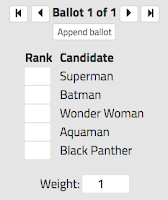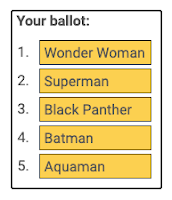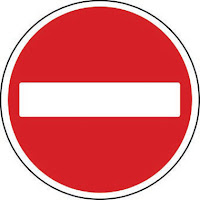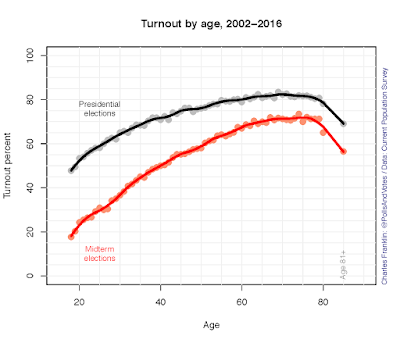Tuesday September 17, 2019
Saturday August 31, 2019
Why we don't support equal rankings in RCV elections
OpaVote specializes in online elections with ranked-choice voting. With ranked-choice voting, you can select your first choice, your second choice, and so forth.
You could imagine that a voter might want to give two candidates the same ranking. For example, using the ballot example here, a voter might want to rank both Wonder Woman and Superman first and rank Black Panther second.
Our user interface does not allow voters to specify equal rankings like this. We occasionally get asked to allow equal rankings in OpaVote, and in this blog post we explain why we won't do so. The fundamental reason is a simple cost-benefit tradeoff.
Benefits of Equal Rankings
The benefit of allowing equal rankings is that the voter has increased ability to express his or her preferences about the candidates.
If a voter truly thinks two candidates are equal, however, then there is no harm in forcing the voter to give the two candidates different rankings. If the voter is equally happy with two candidates, then it doesn't matter to him which is elected, and the order of the two candidates on the ballot doesn't matter.
Accordingly, allowing equal rankings does not give much benefit to the voter because it does not give the voter any increased ability in electing a candidate important to the voter.
Disadvantages of Equal Rankings
One disadvantage of allowing equal rankings is that it can make the user interface for the ballot more complicated. Here is an example OpaVote ballot:
To allow a voter to give two or more candidates the same ranking, we would need to allow the voter to put more than one candidate on the same line. For an election with a large number of candidates (which you should avoid anyway), you might need to allow voters to give 10 or more candidates the same ranking. This would be especially complicated for a ballot on a mobile device.
Another disadvantage with equal rankings is that it makes the counting rules more complicated and harder for voters to understand. Suppose that a voter casts the following ballot:
Initially, I suppose Wonder Woman and Superman would each get half of a vote. But suppose that Superman is later eliminated. Would Superman's half vote get transferred to Wonder Woman or Black Panther? I suppose it makes more sense to transfer the half vote to Wonder Woman, but it makes the counting logic more complicated.
Equal Rankings in Practice
Where ranked-choice voting is used for real government elections (e.g., San Francisco), it is possible for a voter to give two or more candidates the same ranking. The equal ranking is called an "overvote" and it is treated as a voter error. When this happens, there are generally three different ways that that the equal ranking or overvote is handled:
In practice, all ranked-choice voting counting rules that I have seen treat an equal ranking as an error.
OpaVote is actually able to process BLT files that indicate equal rankings (see the BLT file format documentation), and will process them using "Skip" except for San Francisco and Oakland RCV which process them using "Stop".
You could imagine that a voter might want to give two candidates the same ranking. For example, using the ballot example here, a voter might want to rank both Wonder Woman and Superman first and rank Black Panther second.
Our user interface does not allow voters to specify equal rankings like this. We occasionally get asked to allow equal rankings in OpaVote, and in this blog post we explain why we won't do so. The fundamental reason is a simple cost-benefit tradeoff.
Benefits of Equal Rankings
The benefit of allowing equal rankings is that the voter has increased ability to express his or her preferences about the candidates.
If a voter truly thinks two candidates are equal, however, then there is no harm in forcing the voter to give the two candidates different rankings. If the voter is equally happy with two candidates, then it doesn't matter to him which is elected, and the order of the two candidates on the ballot doesn't matter.
Accordingly, allowing equal rankings does not give much benefit to the voter because it does not give the voter any increased ability in electing a candidate important to the voter.
Disadvantages of Equal Rankings
One disadvantage of allowing equal rankings is that it can make the user interface for the ballot more complicated. Here is an example OpaVote ballot:
Another disadvantage with equal rankings is that it makes the counting rules more complicated and harder for voters to understand. Suppose that a voter casts the following ballot:
- Wonder Woman; Superman
- Black Panther
Initially, I suppose Wonder Woman and Superman would each get half of a vote. But suppose that Superman is later eliminated. Would Superman's half vote get transferred to Wonder Woman or Black Panther? I suppose it makes more sense to transfer the half vote to Wonder Woman, but it makes the counting logic more complicated.
Equal Rankings in Practice
Where ranked-choice voting is used for real government elections (e.g., San Francisco), it is possible for a voter to give two or more candidates the same ranking. The equal ranking is called an "overvote" and it is treated as a voter error. When this happens, there are generally three different ways that that the equal ranking or overvote is handled:
- Void -- Any ballot with an equal ranking is void and does not count towards any candidate (even if there is a first choice for a single candidate).
- Stop -- The ballot is counted until an equal ranking is reached. When an equal ranking is reached, the ballot is treated as exhausted and all further rankings (even non-equal ones) are ignored. San Francisco does this.
- Skip -- Any equal rankings on the ballot are skipped and the next single ranking is counted. For the example ballot above, Black Panther would count as the first choice. Cambridge, Massachusetts does this.
In practice, all ranked-choice voting counting rules that I have seen treat an equal ranking as an error.
OpaVote is actually able to process BLT files that indicate equal rankings (see the BLT file format documentation), and will process them using "Skip" except for San Francisco and Oakland RCV which process them using "Stop".
Posted by
Jeff
on
Aug 31st, 2019
Wednesday August 14, 2019
Elections where a winning candidate withdraws
Online elections don't always go according to plan... For example, during an election, it is possible that a candidate may decide that she is no longer able or no longer willing to assume the duties of the position being elected. We describe this as a candidate "withdrawing" from the election. In this post, we explain how to handle withdrawn candidates with OpaVote.
The process works as follows:
Removing a Candidate and Recounting Votes
Let's say that you are the manager of an OpaVote Election. Voting is complete and you have election results. Before you announce the results you learn that one of the winners has withdrawn. OpaVote allows you to remove the withdrawn candidate and recount the votes.The process works as follows:
- Download the ballots from the Election. We have a "Download Ballots" button on the results page.
- Create an OpaVote Count. This is one the three options from our management console.
- Upload the ballots you just downloaded into the OpaVote Count with the "Upload Ballots" button.
- Use the "Withdraw Candidates" button to remove the withdrawn candidate (you can also withdraw more than one if you need to).
- Count the ballots using your preferred counting method.
We will then count the ballots as if the withdrawn candidate had not been on the ballots at all. For example, if the withdrawn candidate was ranked first on a ballot, that ranking will be removed, and the second-ranked candidate will become the first-ranked candidate.
Note that you may need to pay an additional fee for the Count. Though if you do, it is often significantly less than the cost of the Election since the fee is based on the number of votes received and not the total number of voters.
Rerun the Election?
Another thing to consider is whether you should rerun the entire election. For example, suppose there were three candidates competing for a position, you ran the election using plurality or checkbox voting, and the winner withdraws from the election.
You could just elect the person who came in second, but this does not seem fair because you are not taking into account the votes of everyone who voted for the withdrawn candidate. The best option in this situation is to rerun the election.
With ranked-choice voting, you probably do not need to rerun the election, because everyone who voted for the withdrawn candidate will have their votes counted for their second choices.
Posted by
Jeff
on
Aug 14th, 2019
Monday July 1, 2019
Weighted code voters now available
At OpaVote online voting, we already had code voters and weighted voters, but now we have weighted code voters! This feature will be especially useful for HOA and condo elections where a voter's weight corresponds to the size of his or her share of the common condominium expenses.
I'll first review code voters and weighted voters, and I'll then explain how to put the two together.
Code voters work differently. The election manager inputs only the number of code voters. OpaVote then provides the election manager with a list of secret voting codes. It is the job of the election manager to distribute the codes to the voters. The code voters then go to the voting page and enter their code so that they can access their ballot.
Code voters are useful when you don't have an email address for a voter, when two voters share an email address, or if you want to run an onsite election with a voting booth.
A voter with a weight of 2 will have her vote counted twice. It is the same as if the voter actually voted twice. If someone has a weight of 5, it is as if that person voted 5 times. OpaVote currently allows whole number weights up to 1,000,000.
With weighted email voters, the election manager uploads a list of email addresses, and this list can include a weight for each email. With weighted code voters, the election manager just uploads a list of weights, and OpaVote creates a code voter (and corresponding code) for each weight on the list.
If you later increase the number of code voters (without specifying weights), then OpaVote will assign the newly added code voters a weight of 1. If you later decrease the number of code voters, OpaVote will take code voters off the end of your code voter list (i.e., the most recently added code voters), but the weights will otherwise stay the same.
Here is a little trick if most of your voters have a weight of 1. Suppose you have 1000 voters where 5 voters have a weight of 10 and all other voters have a weight of 1. You can upload the following list of weights to create the first 5 weighted code voters:
You have 5 code voters so far. Then, simply increase the total number of code voters to 1000, and OpaVote will add 995 voters, each with a weight of 1.
If you are running an election for an HOA or condo association, then we have a page that explains how to convert the condo shares to weights for use with OpaVote.
I'll first review code voters and weighted voters, and I'll then explain how to put the two together.
Code Voters
OpaVote currently has two types of voters: email voters and code voters. For email voters, the election manager uploads a list of email addresses, and OpaVote sends each voter an email with a special voting link to allow that person to vote.Code voters work differently. The election manager inputs only the number of code voters. OpaVote then provides the election manager with a list of secret voting codes. It is the job of the election manager to distribute the codes to the voters. The code voters then go to the voting page and enter their code so that they can access their ballot.
Code voters are useful when you don't have an email address for a voter, when two voters share an email address, or if you want to run an onsite election with a voting booth.
Weighted Voters
With weighted voters, some voter's votes count more than others. It sounds undemocratic, and this wouldn't be used for most government elections, but it is useful for some elections, such as HOA and condo elections.A voter with a weight of 2 will have her vote counted twice. It is the same as if the voter actually voted twice. If someone has a weight of 5, it is as if that person voted 5 times. OpaVote currently allows whole number weights up to 1,000,000.
NEW: Weighted Code Voters
Weighted code voters work the same as weighted email voters, but the way the manager specifies the weights is a little different.With weighted email voters, the election manager uploads a list of email addresses, and this list can include a weight for each email. With weighted code voters, the election manager just uploads a list of weights, and OpaVote creates a code voter (and corresponding code) for each weight on the list.
If you later increase the number of code voters (without specifying weights), then OpaVote will assign the newly added code voters a weight of 1. If you later decrease the number of code voters, OpaVote will take code voters off the end of your code voter list (i.e., the most recently added code voters), but the weights will otherwise stay the same.
Here is a little trick if most of your voters have a weight of 1. Suppose you have 1000 voters where 5 voters have a weight of 10 and all other voters have a weight of 1. You can upload the following list of weights to create the first 5 weighted code voters:
10
10
10
10
10
You have 5 code voters so far. Then, simply increase the total number of code voters to 1000, and OpaVote will add 995 voters, each with a weight of 1.
If you are running an election for an HOA or condo association, then we have a page that explains how to convert the condo shares to weights for use with OpaVote.
Posted by
Jeff
on
Jul 1st, 2019
Friday June 14, 2019
Elections with a Large Number of Candidates
Some online elections at OpaVote have a very large number of candidates. We'll sometimes see a single contest with hundreds of candidates or many contests where each contest has a large number of candidates.
An OpaVote manager recently asked me the best way to run an election with a large number of candidates. The best answer is don't run an election with a large number of candidates! In some instances, it may be unavoidable, but as an election manager, you should work hard to have a reasonable number of candidates.
In this blog post, we explain (1) why should not have a large number of candidates and (2) if you do, how to improve the process.
In elementary or primary schools, we are taught at an impressionable age that the right to vote is an important part of democracy, and that as good citizens we should exercise that right to vote. But let's be honest, voting is more of a burden than anything. Your job as election manager is to minimize that burden as much as possible so that more of your voters will vote.
One way to reduce the burden is to run elections online. It is certainly much easier to vote from your phone than to travel to a meeting to vote in person (though for some elections you may want people to vote in person). But even with an online ballot, you need to further reduce the burden as much as possible.
There are a number of ways to increase voter turnout, but one of the most important is to have a reasonable number of candidates. Suppose you have 50 people running for a position. Do you expect voters to review the qualifications and platform of each of the 50 candidates to cast an informed vote? In our experience, most voters will be overwhelmed and just not vote.
How many candidates is ok? It depends on the specifics of your election. If it easy for voters to evaluate the candidates (e.g., high school elections where voters know all the candidates) then more candidates is ok. If the voters don't know the candidates and need to do research to understand the candidates, then you should have fewer candidates.
If you are using ranked-choice voting to elect a single person, then we recommend no more than 5 and certainly less than 10 candidates.
If you are using the single transferable vote to elect multiple people, then we recommend no more than 10 and certainly less than 20 candidates.
An OpaVote manager recently asked me the best way to run an election with a large number of candidates. The best answer is don't run an election with a large number of candidates! In some instances, it may be unavoidable, but as an election manager, you should work hard to have a reasonable number of candidates.
In this blog post, we explain (1) why should not have a large number of candidates and (2) if you do, how to improve the process.
Don't Run Elections with a Large Number of Candidates
As an election manager, by asking your voters to vote in an election, you are asking each of your voters to do a favor for you. Your voters are busy people, and they have lots of things going on in their lives. They also get overwhelmed with emails. You are lucky if they open the voting email, never mind clicking a link in the email and then reviewing a list of candidates to cast a vote.In elementary or primary schools, we are taught at an impressionable age that the right to vote is an important part of democracy, and that as good citizens we should exercise that right to vote. But let's be honest, voting is more of a burden than anything. Your job as election manager is to minimize that burden as much as possible so that more of your voters will vote.
One way to reduce the burden is to run elections online. It is certainly much easier to vote from your phone than to travel to a meeting to vote in person (though for some elections you may want people to vote in person). But even with an online ballot, you need to further reduce the burden as much as possible.
There are a number of ways to increase voter turnout, but one of the most important is to have a reasonable number of candidates. Suppose you have 50 people running for a position. Do you expect voters to review the qualifications and platform of each of the 50 candidates to cast an informed vote? In our experience, most voters will be overwhelmed and just not vote.
How many candidates is ok? It depends on the specifics of your election. If it easy for voters to evaluate the candidates (e.g., high school elections where voters know all the candidates) then more candidates is ok. If the voters don't know the candidates and need to do research to understand the candidates, then you should have fewer candidates.
If you are using ranked-choice voting to elect a single person, then we recommend no more than 5 and certainly less than 10 candidates.
If you are using the single transferable vote to elect multiple people, then we recommend no more than 10 and certainly less than 20 candidates.
What to do when you have a large number of candidates?
If you are electing a single person, then here are some changes you can make to reduce the number of candidates:- Run the election in two stages where each stage is an election. In the first stage, people are voting for candidates to make it to the second stage. In the second stage, people are voting for the winner. For example, the first stage may have 20 candidates and the second state may have 5 candidates. The first stage will still be an election with a large number of candidates, but since we are narrowing down the candidates to a pool of 5, the consequences are lower.
- Increase the requirements for becoming a candidate. For example, if 10 signatures are required to become a candidate, then increase the number to 20.
- Split the group into two smaller groups. For example, suppose you are electing a committee of 10 people to represent a city. You can split this into two elections where you are electing 2 committees of 5 people. An example is to split geographically. You can have a committee of 5 to represent east side of your city and a committee of 5 to represent the west side of your city.
- Reduce the number of people being elected. Instead of electing a committee of 10 people, elect a committee of 5 people. This may not reduce the number of candidates directly, but it is something to consider in addition to the above.
Posted by
Jeff
on
Jun 14th, 2019
Friday March 15, 2019
Why I'm against lowering the voting age to less than 18
It is quite rare for me to be against any kind of voting reform. After all, I started OpaVote for the primary purpose of promoting ranked-choice voting. But when it comes to the supposed reform of lowering the voting age from the current standard of age 18 to something lower, I am dead set against it.
Here is my reasoning in a nutshell: I don't see lowering the voting age as having any significant impact in improving voter turnout. To the extent that people or organizations advocate for lowering the voting age, they are distracting us from real reforms that could make a difference.
Voter turnout in the U.S. is quite low. The graph above shows voter turnout by age for U.S. presidential elections and midterm elections. For state and local elections that occur at different times, the turnout is even lower.
Here are some possible voting reforms that could have a huge impact in increasing voter turnout:
Here is my reasoning in a nutshell: I don't see lowering the voting age as having any significant impact in improving voter turnout. To the extent that people or organizations advocate for lowering the voting age, they are distracting us from real reforms that could make a difference.
Voting Reforms that Could Make a Difference
I'll limit myself to voting reforms that are focused on improving voter turnout since that seems to be the objective of advocates of lowering the voting age.Voter turnout in the U.S. is quite low. The graph above shows voter turnout by age for U.S. presidential elections and midterm elections. For state and local elections that occur at different times, the turnout is even lower.
Here are some possible voting reforms that could have a huge impact in increasing voter turnout:
- Making election day a national holiday
- Moving election day to a Saturday or a Sunday
- Allowing early voting or voting over multiple days
- Making it easier to vote by absentee ballot
- Making it easier to register to vote (motor voter laws, same day voter registration, etc.)
- Having state and local elections on the same day as federal elections
Any of the above reforms could have a huge impact in increasing voter turnout.
Lowering the Voting Age Won't Make a Difference
The above graph shows voter turnout by age. The correlation between age and voter turnout is remarkable. Not only do younger people vote less than older people, but there is a continual decline in voter turnout as voters get younger. 18 year olds vote less often than 20 year olds who vote less often than 22 year olds, and so forth.
Suppose that we allow 16 year olds to vote. What is the most logical conclusion? That 16 year olds will vote even less often than 18 year olds. What does that accomplish? Not much.
Some proponents of lowering the voting age contend that lowering the voting age will somehow increase voter turnout across the board. I suppose the idea is that if we instill the importance of voting to impressionable youngsters, then they will be more likely to vote throughout their lives. It sounds nice, but given the above chart, I just don't believe it.
What age if not 18?
We need some age threshold for voting, and we are not going to allow infants to vote. An age threshold of 18 seems like an eminently reasonable choice since many legal rights start at age 18.
There are some rights that occur at less than 18 years of age. Children less than 18 can work, pay taxes, and drive cars. But these other rights occur at all different ages and vary from state to state. For example, 14 year olds in Alaska and North Carolina can get married.
Most proponents of lowering the voting age focus on lowering the age to 16. But if 16, why not 14, if 14 why not 12. Where do we stop?
For better or for worse, age 18 is the traditional age of adulthood in the United States, and many important rights are conveyed at this age, such as emancipation from your parents. It is hard to justify another age that makes more sense than 18.
Other Considerations
In my view, the arguments presented above make it clear that we should keep the voting age at 18. There are other considerations as well, however, and I present these last because they are more controversial and because I'm not really qualified to opine on them. For that reason, I'll present them as questions and not try to answer them.
If the voting age is reduced to an age less than 18, will parents improperly influence their children or even force them to vote a certain way? It seems that parents could enter voting booths with their children. How would we prevent that?
Brain development progresses rapidly with teenagers and continues until we reach 25-30 years (interesting article). The brains of 18 year olds are certainly more developed than 16 year olds. How do we take this into account when determining the voting age?
An interesting side note. The article linked above states that the development of girls' brains is about two-years ahead of boys' brains. Maybe we should have a voting age of 18 for boys and 16 for girls?
Posted by
Jeff
on
Mar 15th, 2019
Wednesday March 13, 2019
Largest Election Ever with 57,000 Voters
Our largest election ever was completed yesterday with a total of 57,000 voters. Although we've carefully designed our online voting platform to scale to handle elections of any size, we must admit that we do get a little nervous when a customer has an election that goes where no election has gone before!
One amazing aspect of modern cloud computing is the ability to quickly scale the number of servers running your website behind the scenes. For typical daily usage of OpaVote, we have a relatively small number of servers, but when a large election starts, the number of servers will increase quickly to handle the sudden increase in traffic. When the traffic slows down, the number of servers will decrease so that we are not paying for computing power that we don't need.
The graph here shows the change in the number of servers when the election with 57,000 voters started. We are happy to report that the election with 57,000 voters went off flawlessly.
One amazing aspect of modern cloud computing is the ability to quickly scale the number of servers running your website behind the scenes. For typical daily usage of OpaVote, we have a relatively small number of servers, but when a large election starts, the number of servers will increase quickly to handle the sudden increase in traffic. When the traffic slows down, the number of servers will decrease so that we are not paying for computing power that we don't need.
The graph here shows the change in the number of servers when the election with 57,000 voters started. We are happy to report that the election with 57,000 voters went off flawlessly.
Posted by
Jeff
on
Mar 13th, 2019






